The rainforest is one of the ideal habitats for monkeys. Plenty of food and great protection are offered to the species that live high up on trees here.
Some monkeys can also live on the ground, taking advantage of the various foods found on the forest floor.
Here are some of the typical monkeys that live in the rainforest with some of their most specific characteristics of eating, breeding, and socializing.
Table of Contents
1. Olive Baboon
Olive Baboons (Papio anubis) have a widespread habitat in multiple countries in Africa. This is a species also present in the rainforest, alongside its more difficult conditions it also lives in the desert.
A true omnivorous species of the rainforest, The Olive Baboon is also more adaptable than other baboons.
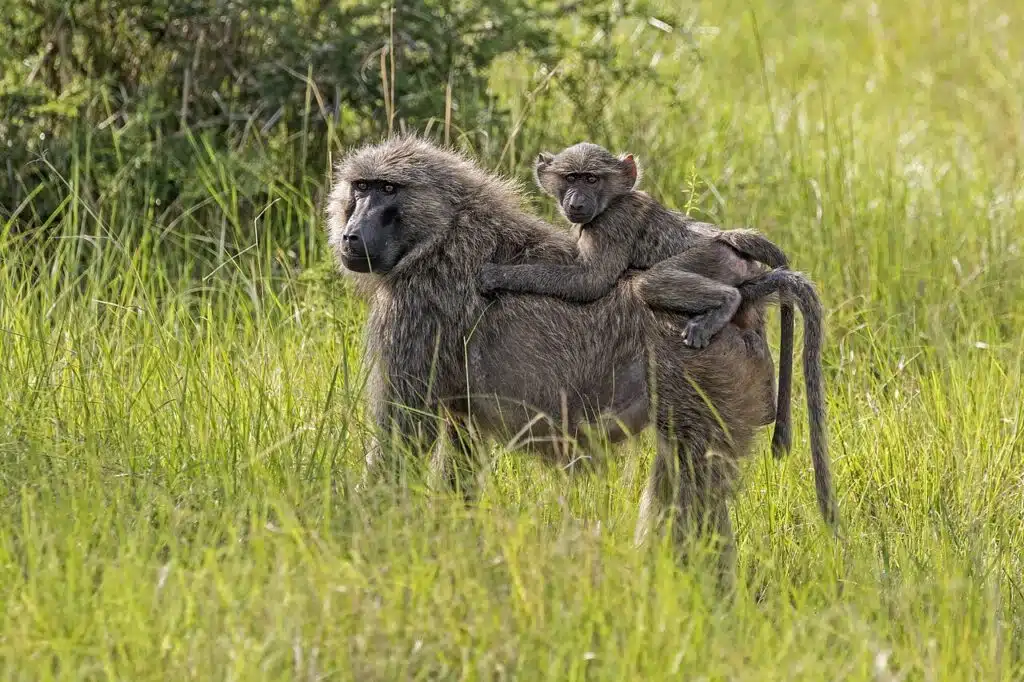
This is a species that can eat on the ground and off the ground up on trees.
From fruits and seeds to mushrooms and birds, Olive Baboons can easily find food in almost any type of habitat.
They live in groups, feeding together. These groups are mostly made up of females, with just a few males.
Clear hierarchy is specific to males while females pass on their hierarchy to their female offspring
2. Lion-Tailed Macaque
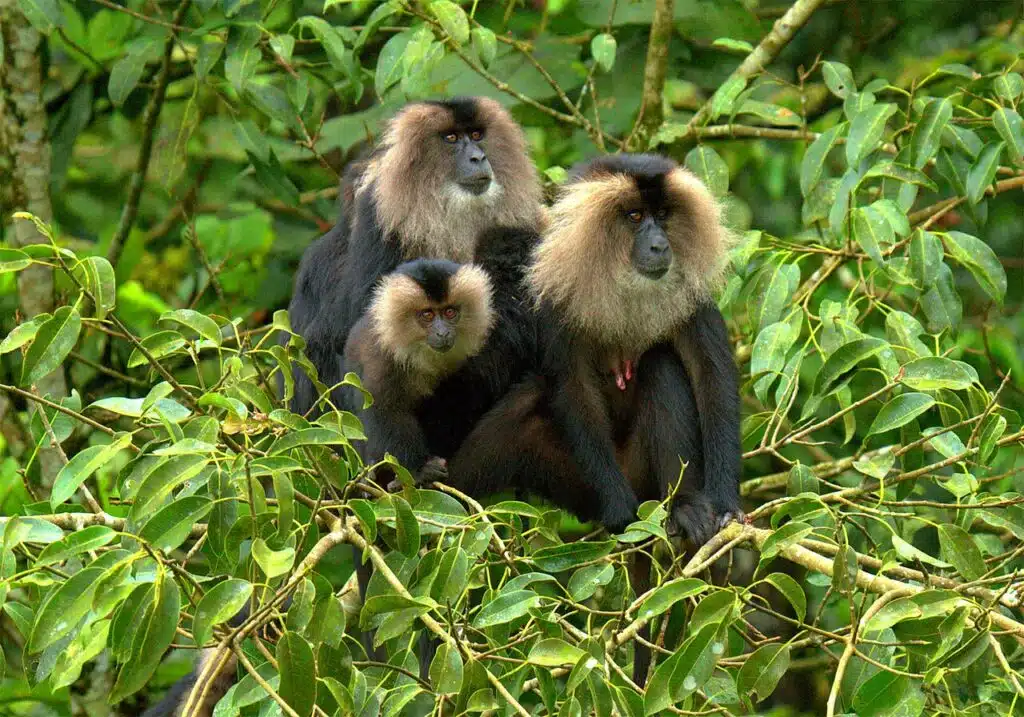
Unlike the versatile Oliva Baboon, Lion-tailed Macaques (Macaca silenus) are only found in the rainforest. This species is found in India’s humid forests where it lives an arboreal life.
This is a small type of monkey with a gray-silver mane and a black face without hair.
Mostly active during the day, the Lion-Tailed Macaque spends at least a few hours eating and a few hours resting.
Whatever time is left of the day is spent looking for new food sources, either in small groups or in large groups.
Most Lion-Tailed Macaque groups are small, with up to 3 males. One male is always dominant in groups with multiple males.
3. Blue Monkey
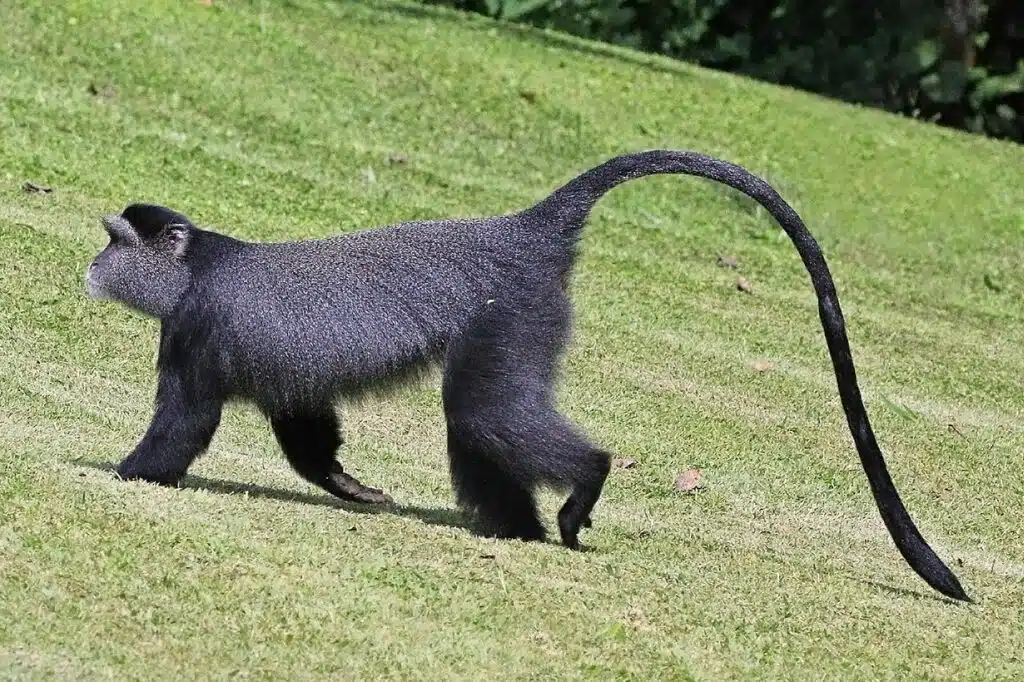
Rainforests are part of The Blue Monkey’s (Cercopithecus mitis) habitat, a species that isn’t blue.
Mainly gray, black, and olive, this species may only show scarce blue hairs on its face.
Found in the deep forest in areas without much sun, these types of monkeys are frugivores first. Eating mostly fruit, these types of monkeys can also eat flowers, insects, and other species.
They live in small groups under the rule of a single male while all other males are either part of other groups or venture out on their own.
4. Red-tailed monkey
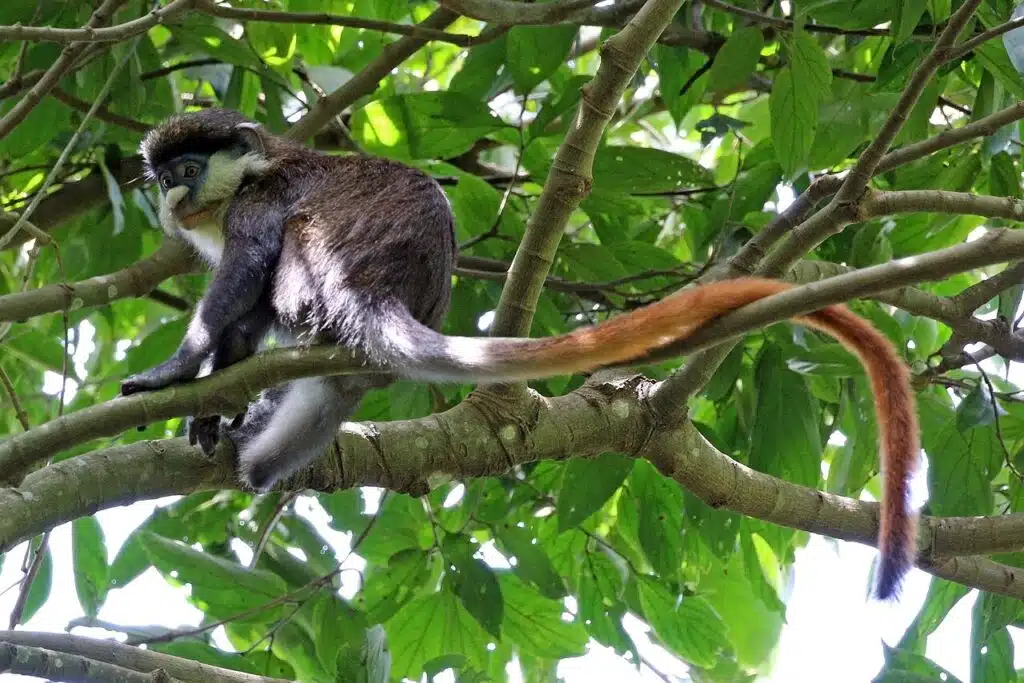
Angola, Cameroon, and Uganda are among the monkeys of Central Africa that live in the rainforest.
Unlike a few other species that live in the rainforest, Red-Tailed Monkeys (Cercopithecus ascanius) live both on trees and on the ground, depending on the foods they’re after.
Most times these monkeys climb down from trees in the morning or the evening.
The appearance of the species also makes them stand out in the rainforest. Red-tailed monkeys have blue faces, yellow sides, and contrasting red tails.
The tail itself can be as long and even longer than the body of the monkey.
5. De Brazza’s Monkey
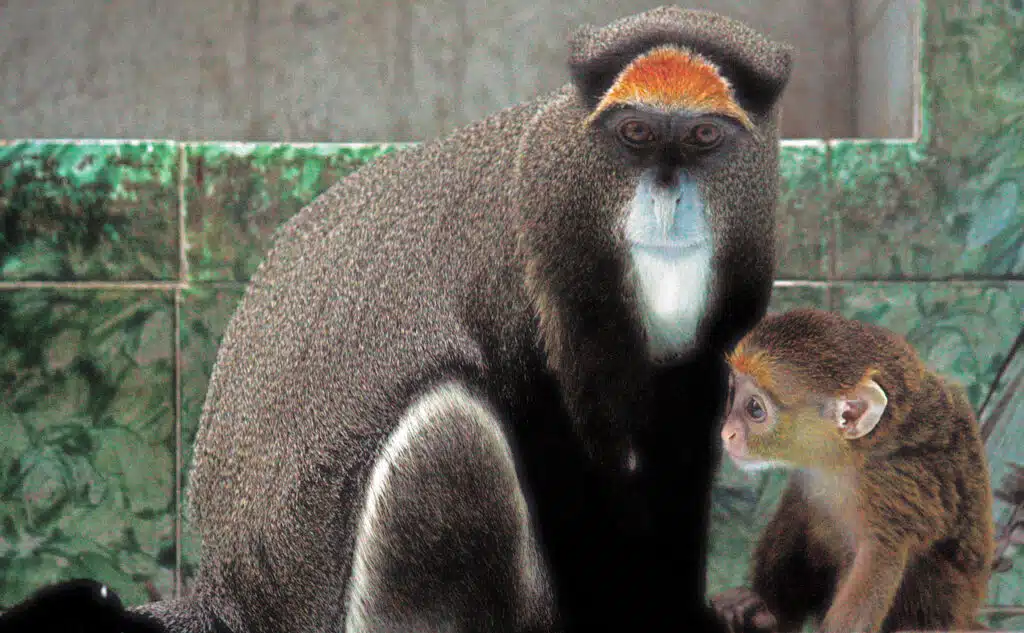
Some monkeys of the rainforest have very distinct physical traits which makes them instantly recognizable.
De Brazza’s Monkeys (Cercopithecus neglectus) are among these species as they have a contrasting white beard on grey fur.
A species of African rainforest, this is a family of monkeys found across multiple states such as Congo, Equatorial Guinea, Kenya, and Sudan.
They make the most of the foods they can find in their expansive rainforest habitat. Most of their foods are fruits and seeds.
These are foraged both up on trees as well as on the forest floor.
Generally aggressive, De Brazza’s Monkeys may only not show aggression towards other rainforest monkeys in their habitat that eat leaves.
6. Black Colobus
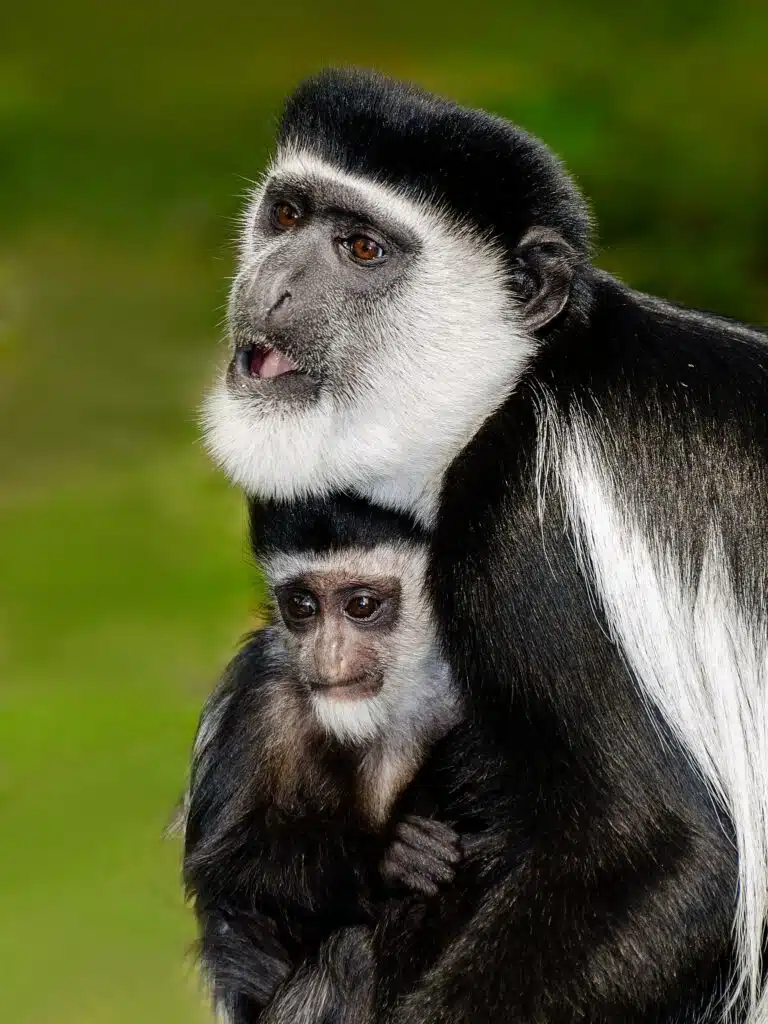
From Gabon to Cameroon, Black Colobuses (Colobus satanas) are among the multiple species calling the rainforest their home.
This is a type of monkey that prefers dense rainforest areas and which may occasionally be seen along the coast.
Mostly black, with a long white mantled, Black Colobuses feed on seeds.
Their long and curved teeth are adapted for different types of seeds which they can crack open.
Hunting is one of the reasons why this species may be endangered. A relatively small social group is another reason why these monkeys aren’t more numerous in the rainforest.
7. Black Bearded Saki
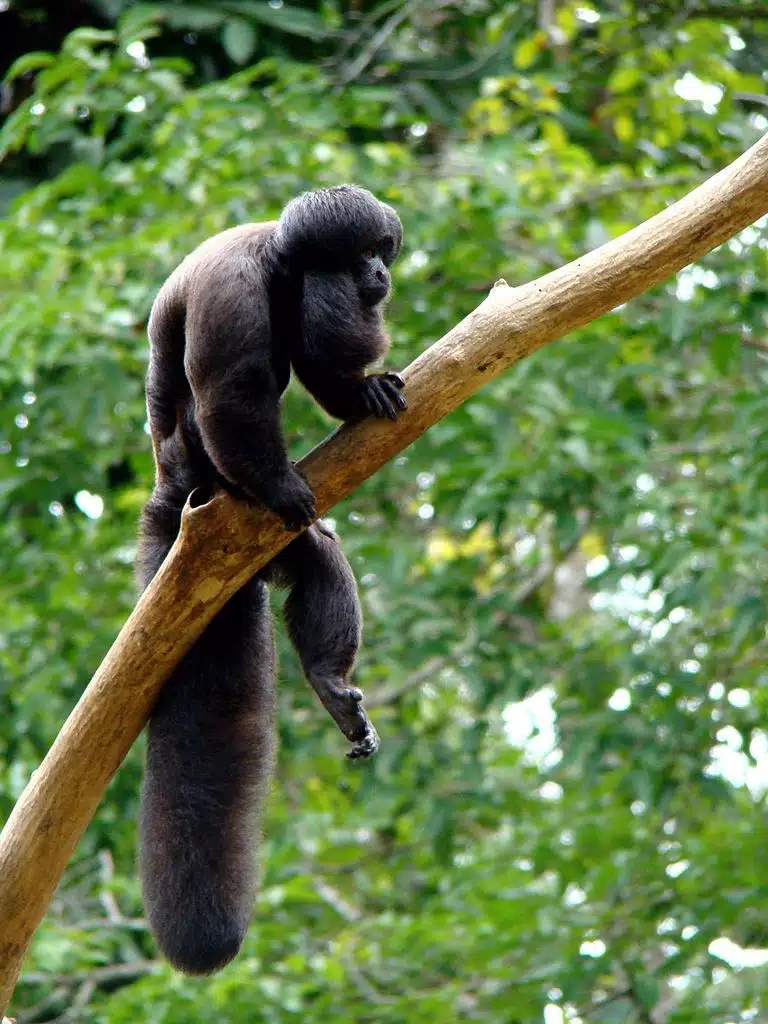
A species of The Amazon Rainforest, Black Bearded Sakis (Chiropotes satanas) are among the species only found in a small area.
This is a species that doesn’t travel far within the rainforest, mostly specific to a secluded Northeastern area.
Mostly moving on trees, this is a species that may venture out of the group on its own during the day.
This is done either for food or to seek breeding partners from other groups.
Black Bearded Sakis live in small groups of up to 20 males and females.
It takes a few years for them to reach breeding age as the expected lifespan of these monkeys is up to 18 years.
8. Mantled Howler
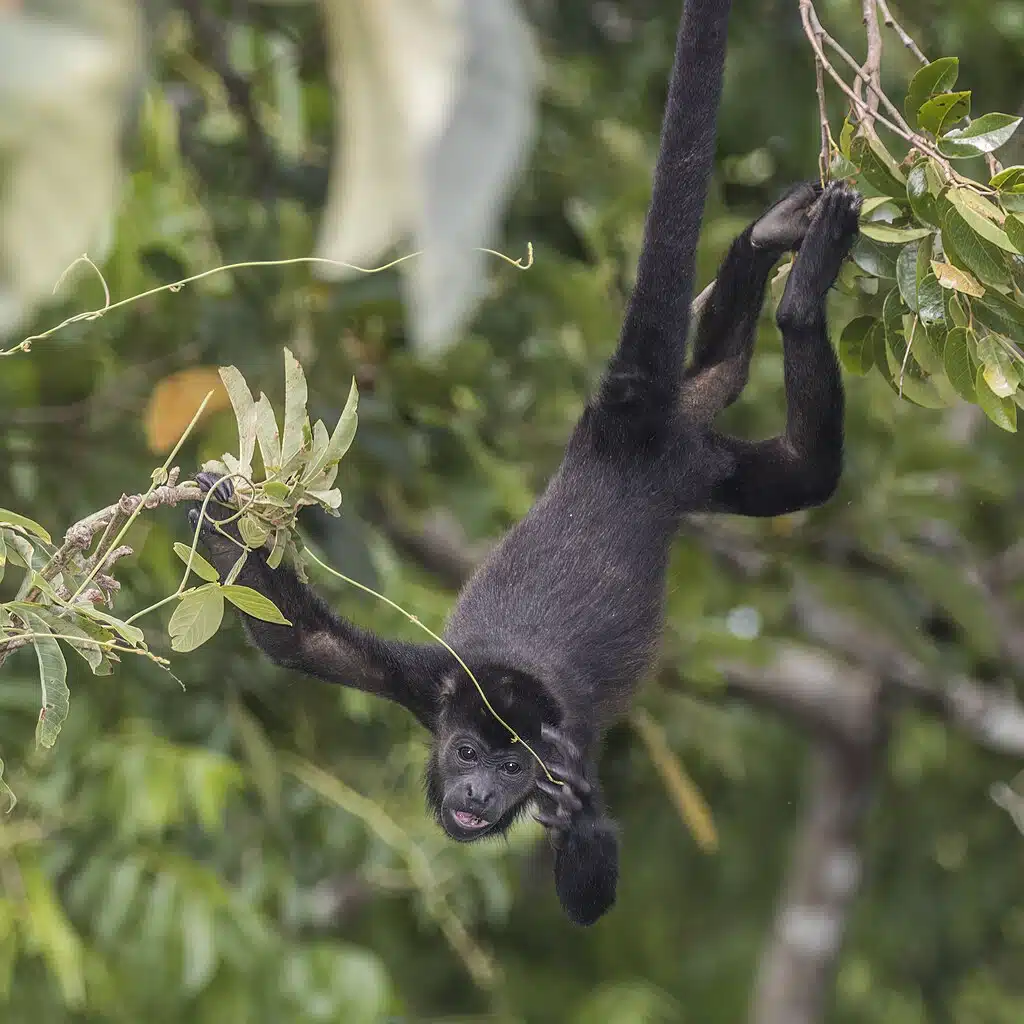
Central American and Northern South American rainforests are home to The Mantled Howler (Alouatta palliata).
This is a species that shows vulnerability to the rainforest fragmentation here even if it lives both on trees and on the ground.
The role of the species in the local rainforest ecosystem is important. Monkeys of this family feed on fruit and seeds, helping disperse them through the rainforest.
A distinct social structure is specific to this species. They live in large groups which they leave once full adults.
This is why Mantled Howlers never breed among the same family members and they form distinct groups of up to 40 males and females.
9. Silvery Marmoset
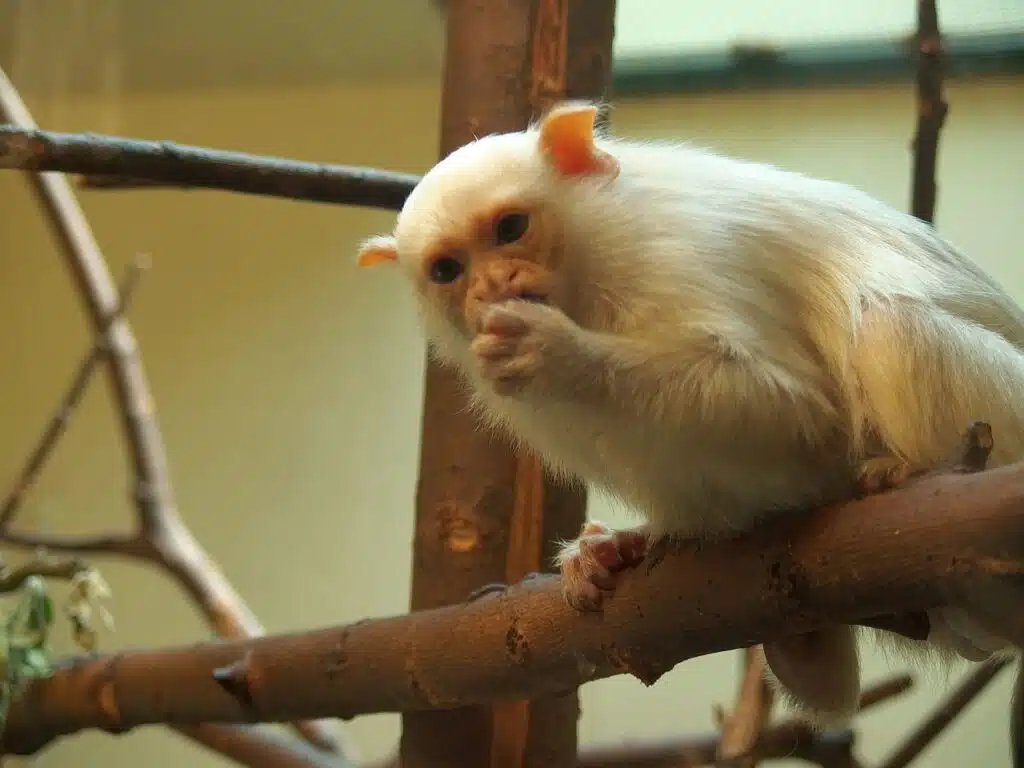
An arboreal species of The Amazon Rainforest itself, Silvery Marmosets (Mico argentatus) are among the smallest bright monkeys in the world.
This is a white species with pink-red ears and faces that feeds on tree sap, unlike most other species in these humid forests.
It lives in small groups and does its best to only occupy dense areas of the rainforest where it can hide from potential predators.
Small groups are specific to these types of monkeys where females give birth to a couple of offspring. Fathers care for one while mothers care for another.
10. Masked Titi
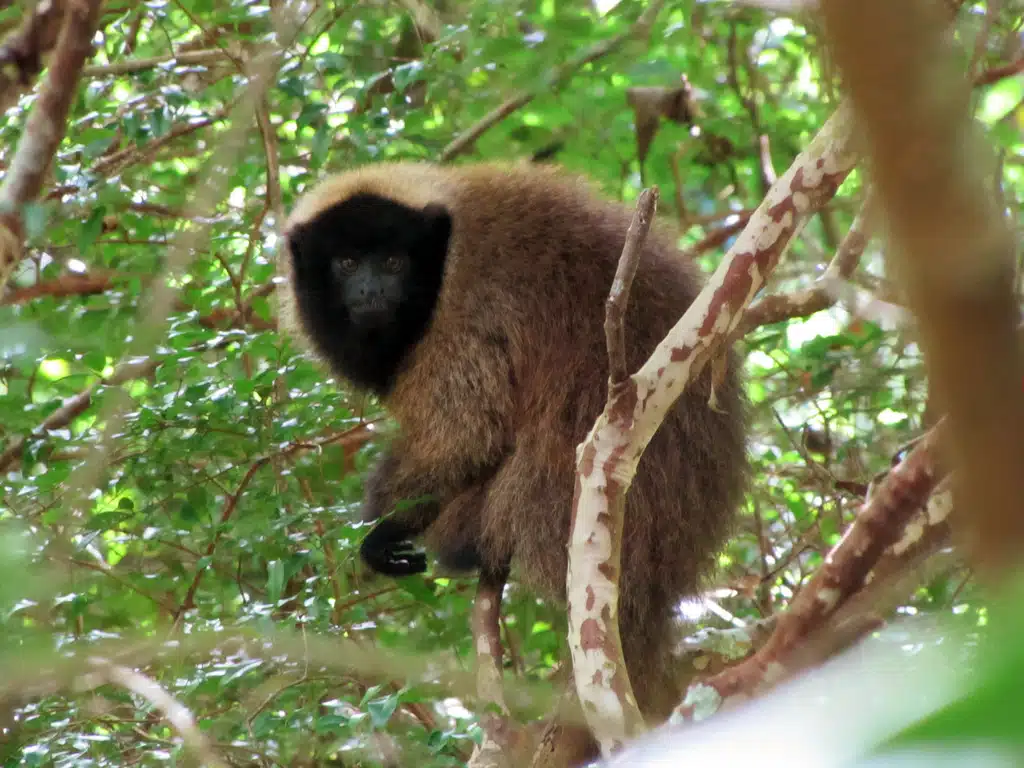
The term mask refers to the colored (typically darker) nuance of a species’ face. Masked Titis (Callicebus personatus) have a black face and brighter hairs across the body.
Almost all of their lives are pend high up on the trees of the Southeastern Amazon.
Fruits and insects are typically found on trees as these monkeys are afraid to climb down on the floor because of snakes.
One of the major obstacles they face is the human intervention in the rainforest.
Unlike other species, Masked Titis aren’t afraid of humans and continue to live in their presence if there’s food around.
11. Black-Capped Squirrel Monkey
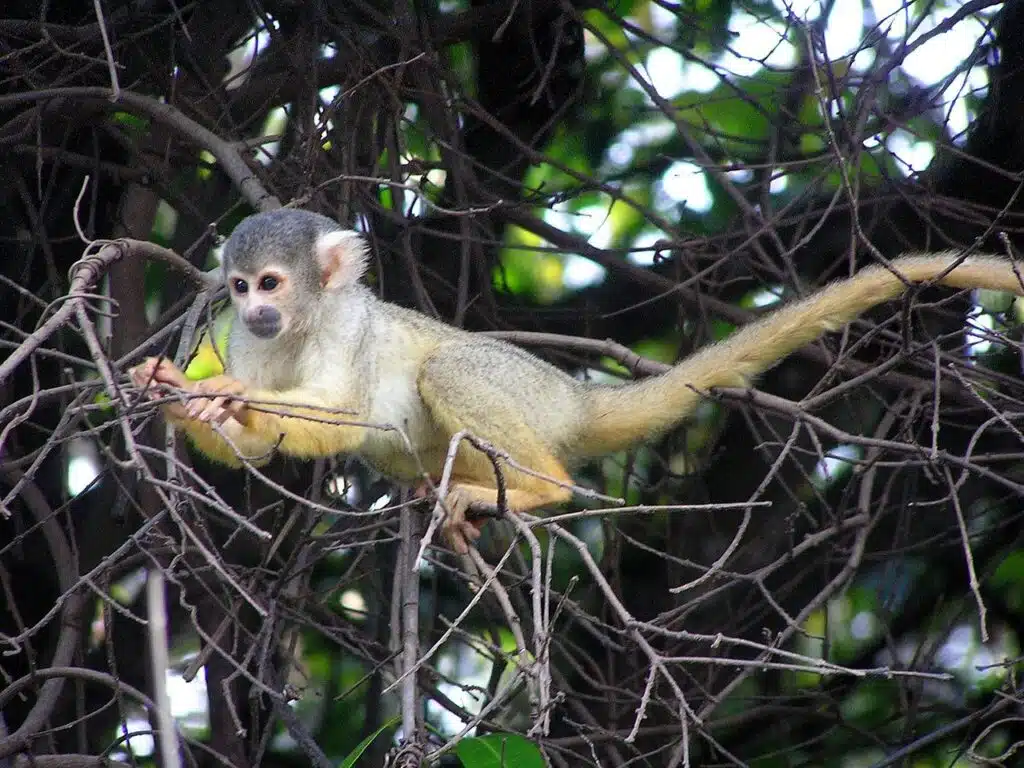
A species of The Western Amazon, Black-Capped Squirrel Monkeys (Saimiri boliviensis) live both in the rainforest and in nearby plantation forests.
These types of monkeys are named after their black headtops and are easier to spot than other species given their live in large groups.
Mostly formed from females, these groups can number up to 75 individuals.
A species found in the dense rainforests, Black-Capped Squirrel Monkeys live on trees in swamps, next to water, and in dense vegetation.
They live close to other groups but males may also live on their own as they venture out as soon as they reach sexual maturity.
12. Maroon Langur
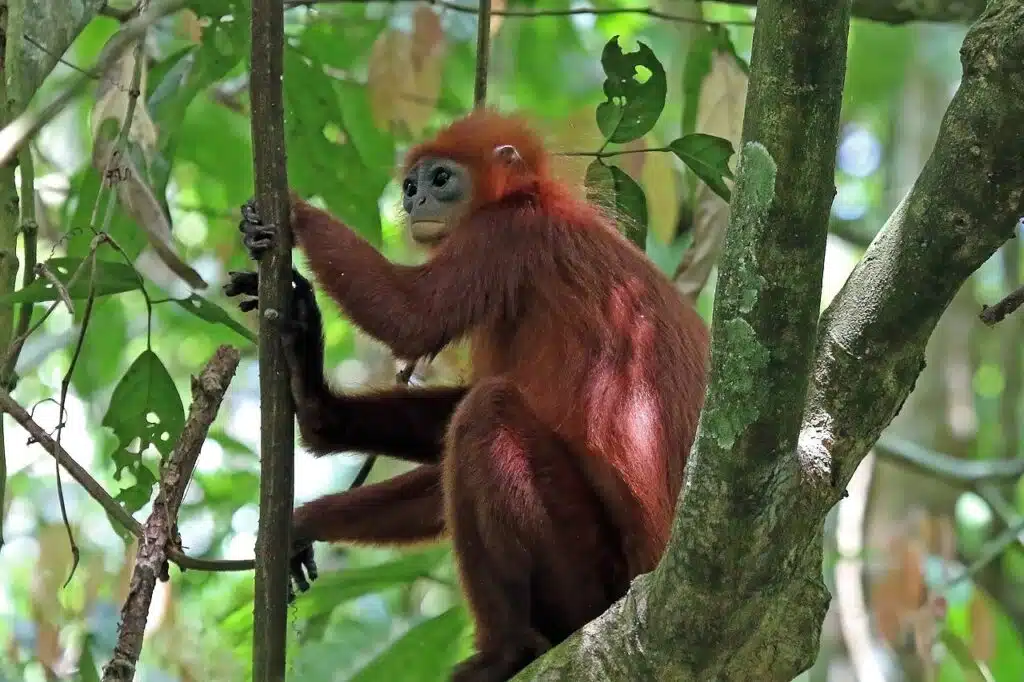
These red monkeys (Presbytis rubicunda) with black faces are a rare sight. They only live in the rainforest of Borneo.
While the rainforest here isn’t as endangered as in other areas, these monkeys are only found in small groups as they only live on specific tree species.
This means they spend a lot of time up on trees in areas that may be flooded or on swamps throughout the year.
Leaves form an important food source of the species but these monkeys may also eat seeds off the ground in the drier periods of the year when they can move on the ground.
13. Common Woolly Monkey
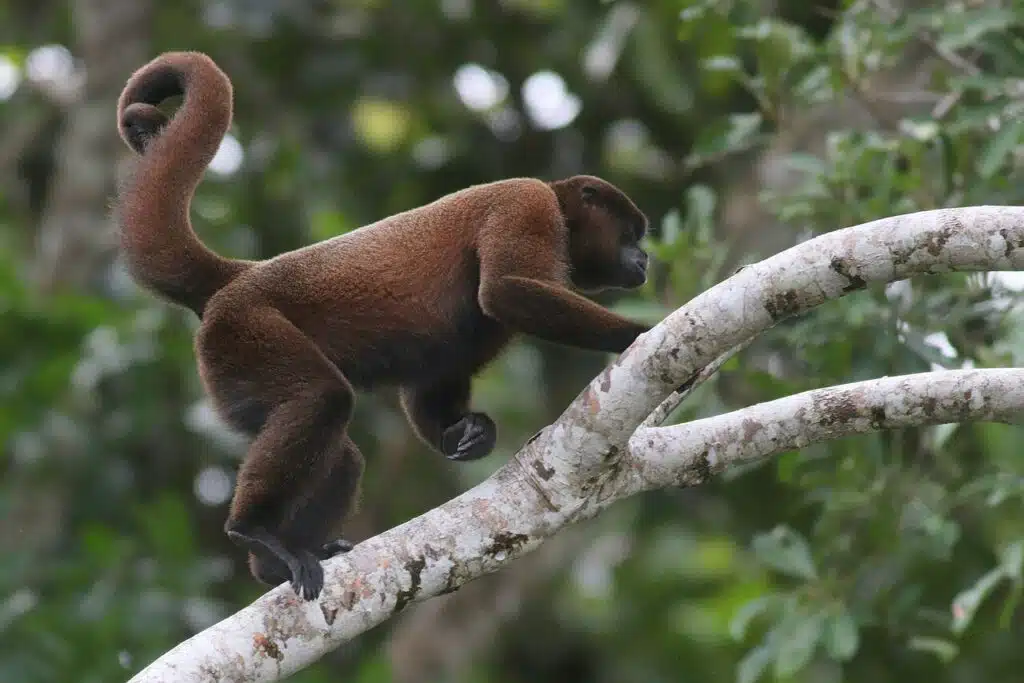
Mostly grey and brown or black on the head, The Common Wooly Monkeys (Lagothrix lagothricha) are found in the rainforest of South America.
It prefers dense areas of forest and even flooded areas of the forest as excess water typically prompts the growth of some of its favorite fruits.
Their movements in the rainforest are largely dictated by what fruits are in season, depending on high and very high rainfall.
This is why these types of monkeys don’t eat leaves but may eat them in the periods when they cannot find fruit.
14. Golden-faced Saki
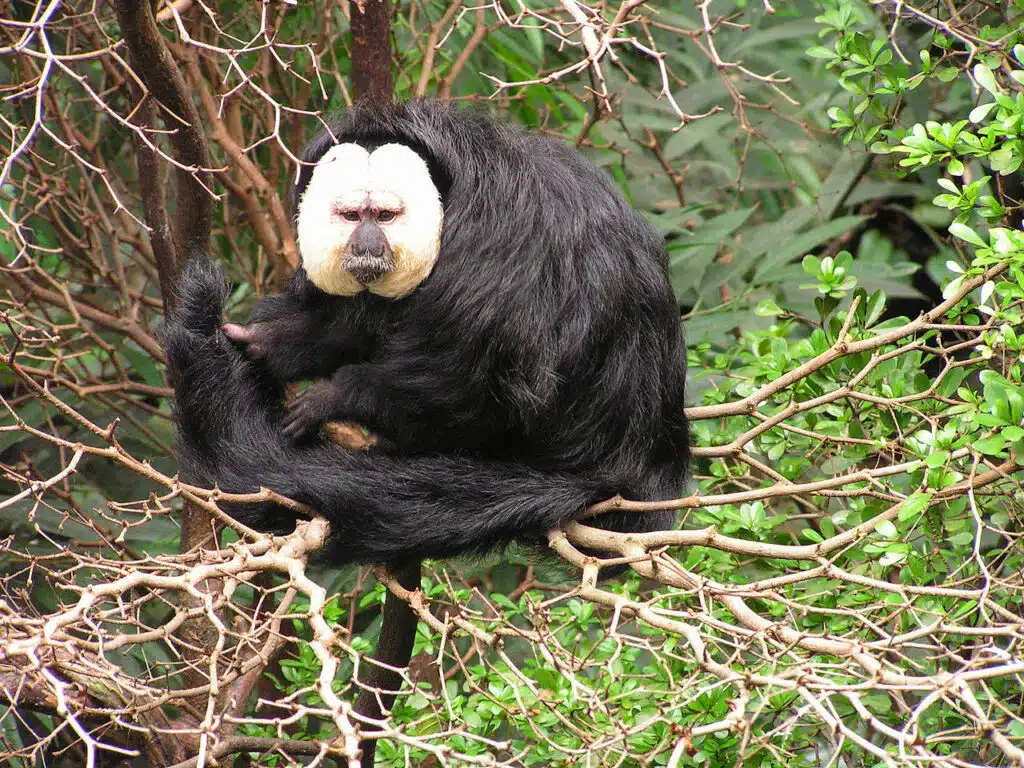
Named after the appearance of its males, this (Pithecia chrysocephala) is a species with orange-brown or brown faces and black bodies.
Males of the species are also known for having rather round heads, which makes them easy to differentiate.
While they look similar to their cousins, The White-Faced Sakis, these monkeys still have plenty of differentiating traits.
They are a species of The Amazon, a rainforest where monkeys live in groups of at least 10, across multiple subspecies.
Golden-faced Sakis live in smaller groups and even in pairs, which makes them different from a social perspective.
15. Brazilian Bare-faced Tamarin
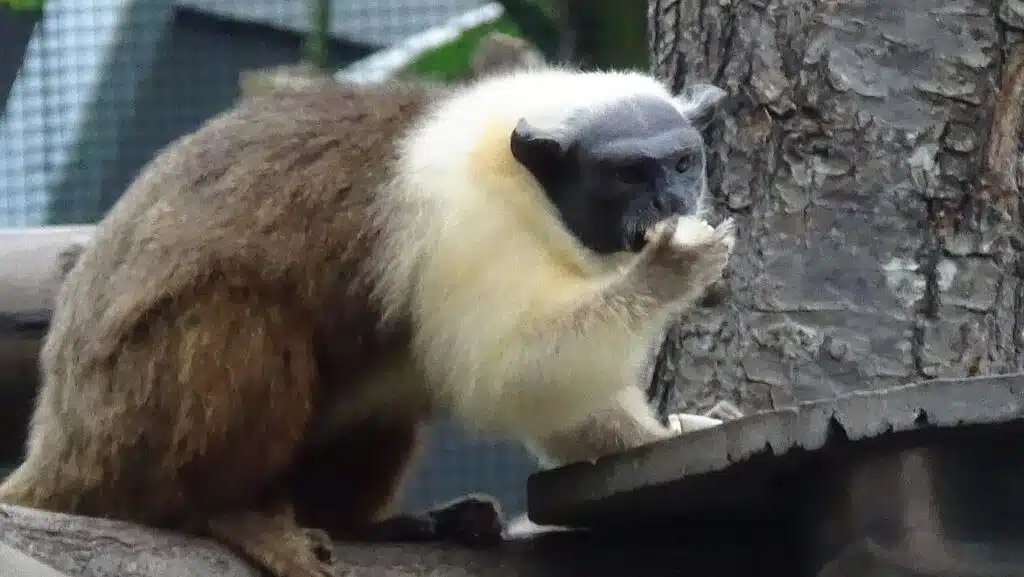
The Brazilian Bare-faced Tamarin (Saguinus bicolor) is a small type of monkey endemic to The Amazon rainforest.
Monkeys of this group are also known as Manaus Monkeys since they live on the outskirts of Manaus, the capital city within The Amazon itself.
This small species even lives among the locals, often spotted on the streets of the city.
It also lives among the forests of the city and it is believed the city expansion further limits its natural habitat in the region.
Fruit is among the common foods of the species identified by its white body, black face, and black ears.
16. Brown Capuchin
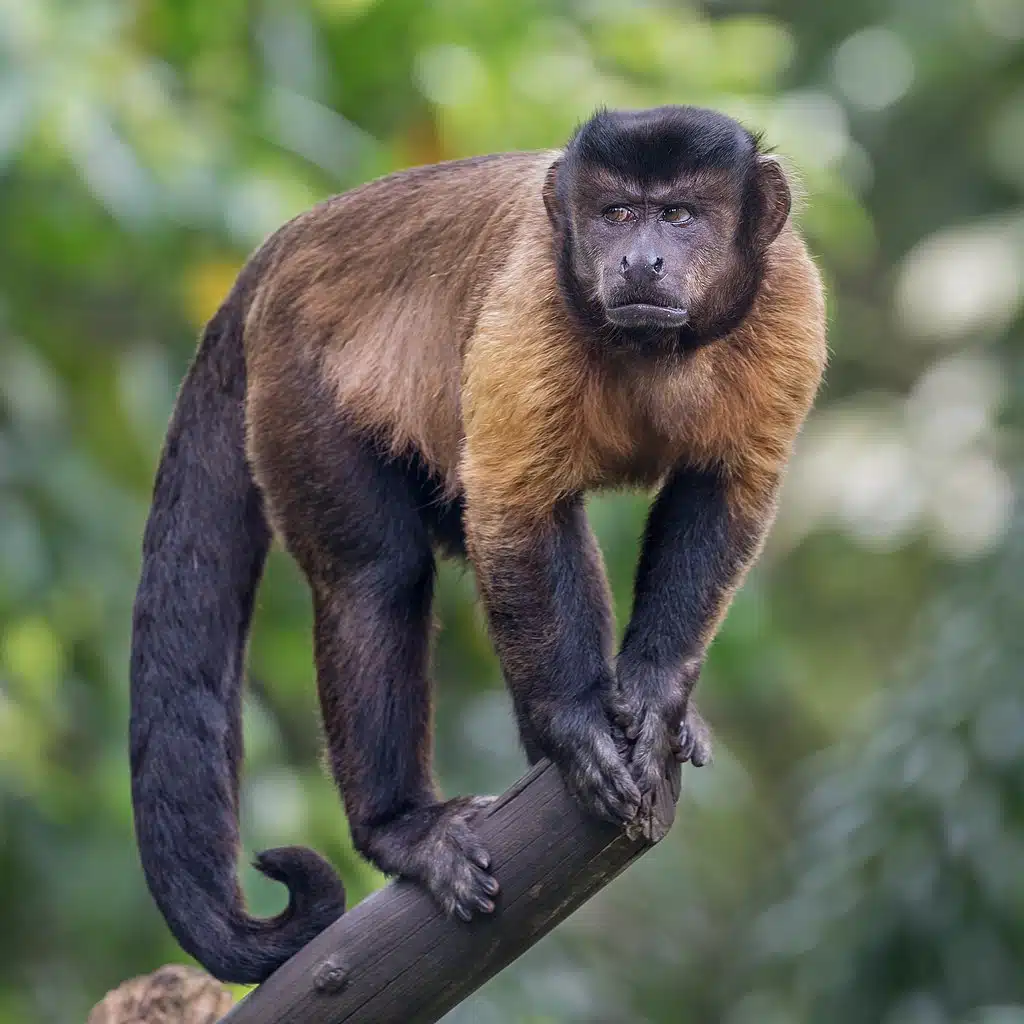
Brown and black, The Brown Capuchin (Sapajus apella) is a small monkey of the tropical rainforest in South America.
Its presence spreads through The Guyanas, Venezuela, and Western Brazil.
As an arboreal species, these monkeys feed not only on fruit but also on vertebrates and invertebrates such as frogs.
They do this in small groups of up to 20 individuals mostly females, offspring, and a single male. Multiple males are rare within the same group.
A single alpha male forms the group and also dominates the group in front of potential other lower-hierarchy males.
17. Colombian Red Howler Monkey
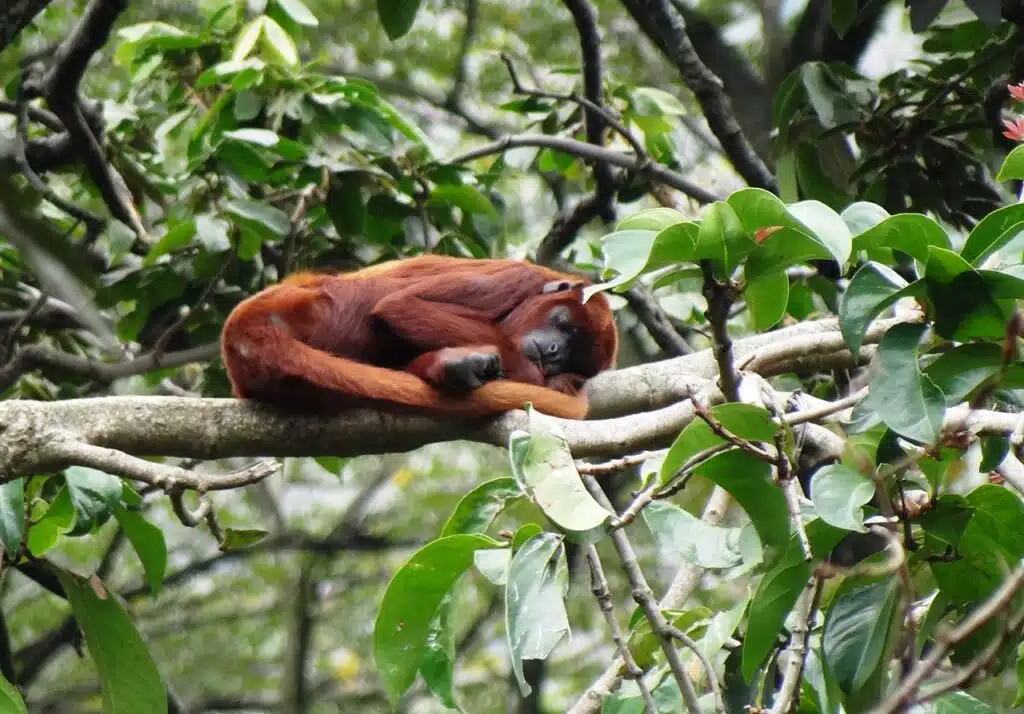
A type of loud roaring monkey, The Colombian Red Howler (Alouatta seniculus) is a species that lives in the Northwestern forest of South America.
Known for its red-brown hairs, this is a round head species with fur on its head and a black face.
Much of its diet is based on leaves, followed by fruit, and seeds. Living both on the ground and up on trees, this is a species that prefers small groups.
5-9 males and females from a social group with the Colombian Red Howler Monkey.
These groups can be aggressive to other groups but keep away from their roars so that they don’t intersect.
18. Spix’s White-fronted Capuchin
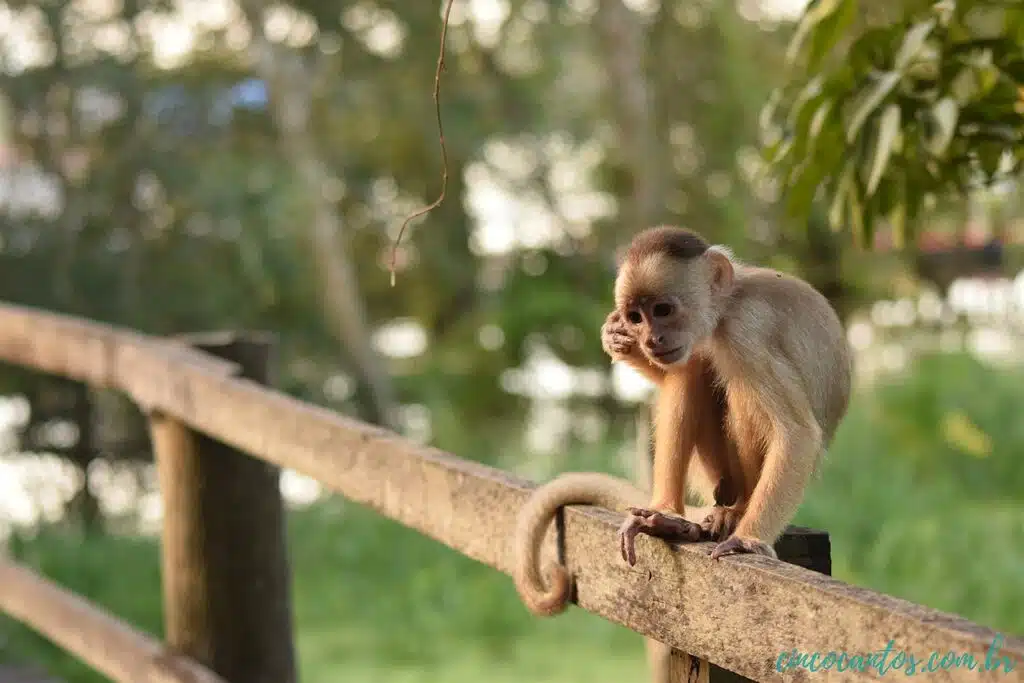
This small monkey (Cebus unicolor) is native to the forests of Brazil and Peru. It features a brown and black color with bright fur and a white collar.
Only growing to 15 inches, this small monkey lives in groups on the ground.
It may climb trees but it forages on the ground. Fruit, insects, and leaves are part of its diet.
This terrestrial type of monkey is found in open areas of the woodlands, dense forests, as well as in grassland.
Due to its low numbers, it’s considered a vulnerable species in the rainforest.
19. Saddleback Tamarin
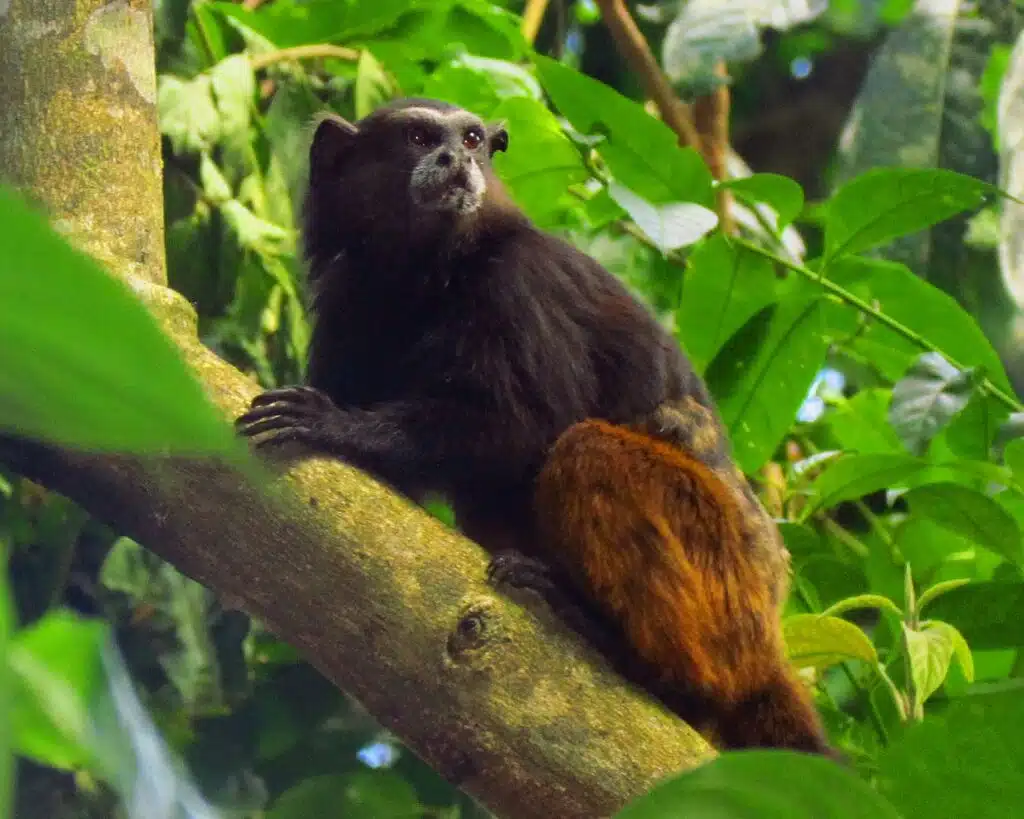
This dark brown and black type of monkey is specific to the Northern regions of The Amazon Rainforest.
The species (Saguinus fuscicollis) is arboreal and has a diverse diet based on the fruits and arboreal frogs or insects it finds here.
A group is formed by multiple males and multiple females. However, only one female of the group is allowed to breed and the offspring are raised by the entire group.
Saddleback Tamarins sleep in tree cavities and hollow spaces to get some protection from predators.
They also use a range of vocalizations to alert others of a potential intruder in the area. A whistling vocalization is also specific to these monkeys.
20. Eastern Pygmy Marmoset
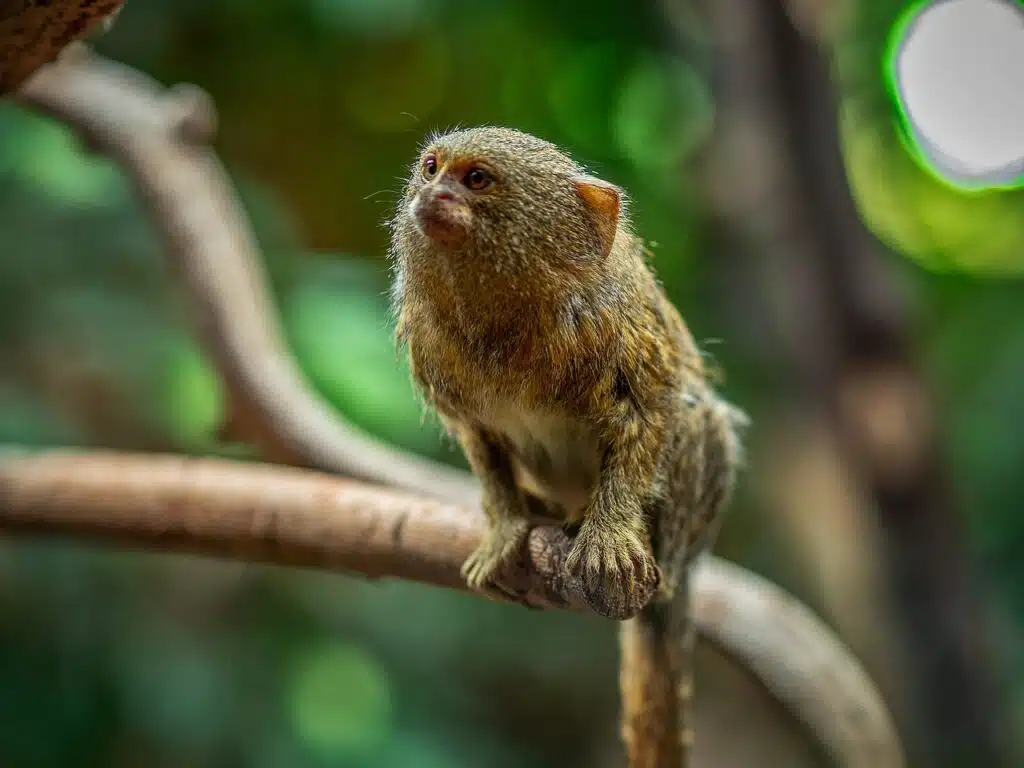
Some of the smallest primates in The Amazon, The Eastern Pygmy Marmoset (Cebuella niveiventris) only grows to a few inches.
The species mostly feeds on plant sap and it has a few physical adaptations that allow it to feed on sap.
For example, it has sharp teeth as well as long claws that allow it to dig deep under tree bark for sap.
On occasion, it may also feed on insects. Eastern Pygmy Marmosets also use their atypical long claws to grab on branches when moving in the canopy.
The species is mostly found along the Amazon River and feeds on tree trunks.
21. Bald Uakari
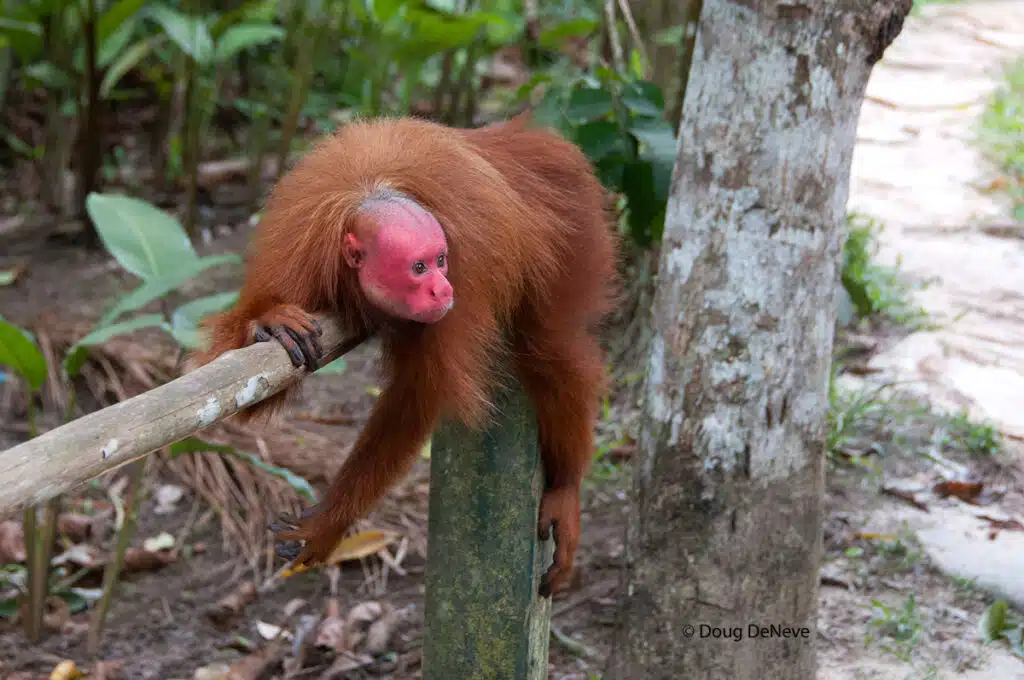
Bald Uakaris (Cacajao calvus) are named after their round bald heads. Red exposed skin is specific to the head of these brown monkeys.
Their presence is specific to the rainforests of Brazil and Peru.
Bald Uakaris are both terrestrial and arboreal, depending on the season. Floods are common in the rainforest and prompt its arboreal habits.
Once water retreats, this is a species that also moves down on the ground for food.
The foraging habits of the species are similar to those of other monkeys with an average of 2 miles covered each day either for food or for finding a breeding partner.
22. Coppery Titi
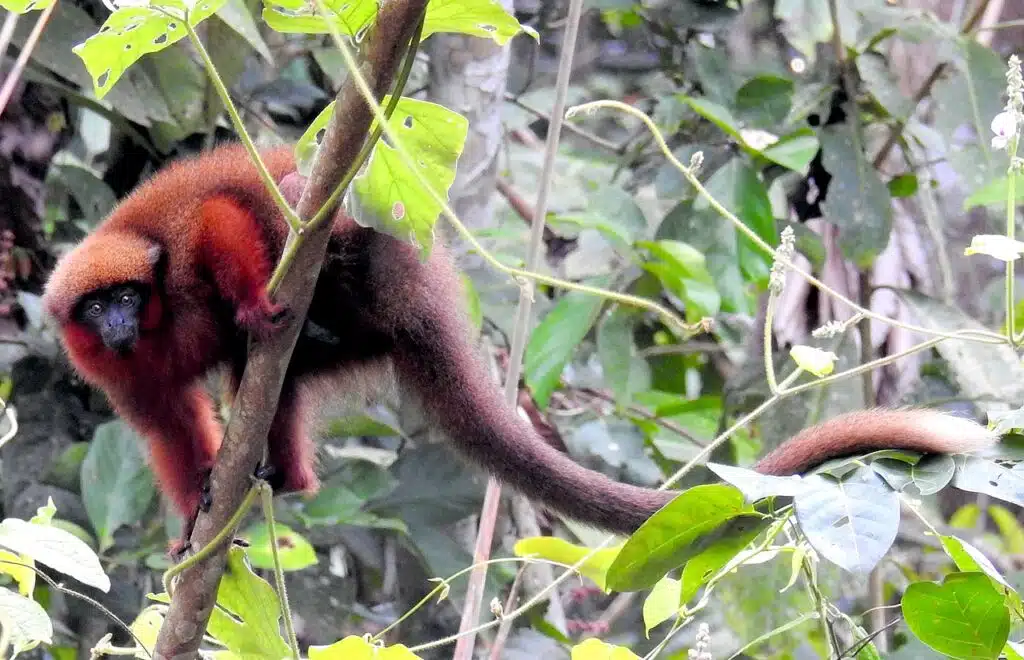
Mostly feeding on fruit and insects, these brown-copper monkeys (Plecturocebus cupreus) have a red collar and black hairless face.
Tropical and subtropical forests are specific to their habitat, mainly in floodable lowlands.
This is where the species finds plenty of tree fruit to feed on. At the same time, they help spread the seeds of the fruits they consume, despite facing many predators such as birds.
Coppery Titi monkeys live in small groups with a single male adult.
Females of the group care for the offspring which remain with the group for several years.
Male-female pairs formed in these groups don’t breed with others, as with other species, and keep on breeding for life.
23. Black-faced Black Spider Monkey
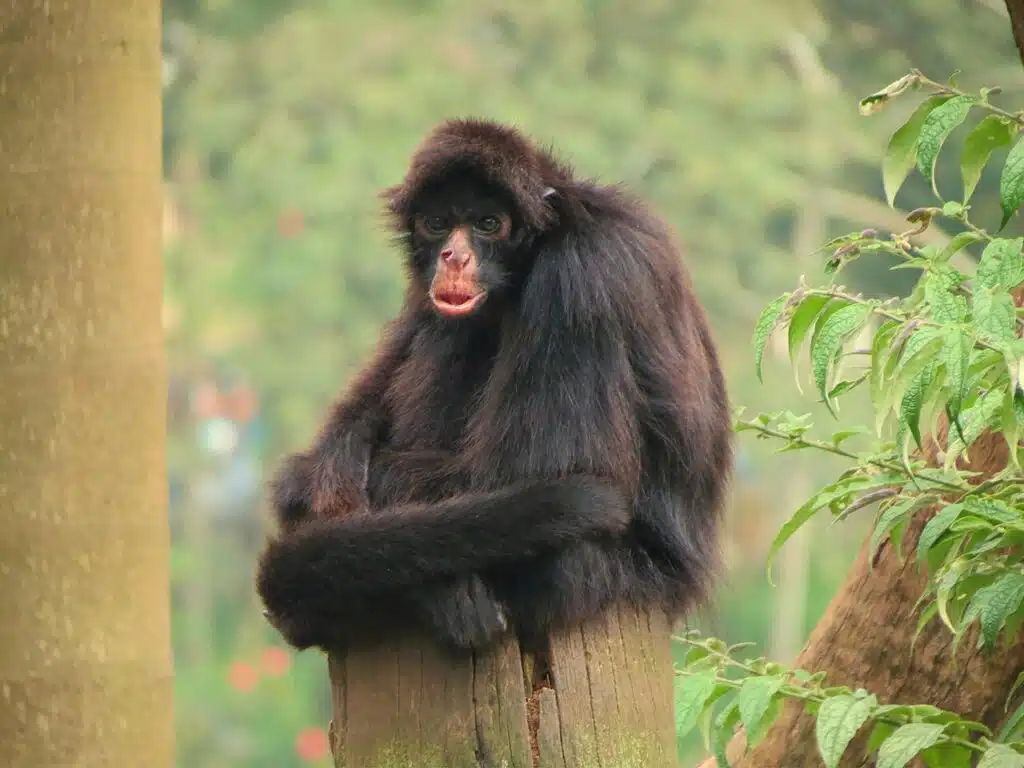
Found across Peru and Brazil, this rainforest species (Ateles chamek) has a dark appearance almost all-black hair, and a pink-red mouth and nose.
They live in small groups but tend to disperse during the day to form the group back at night.
Females of the species that are about to give birth also leave the group for areas considered more abundant in food.
Reaching a size of up to 20 inches, the monkeys can live long lives when there’s sufficient fleshy fruit around.
They can survive up to 20 years in the wilderness.
24. Mustached Tamarin
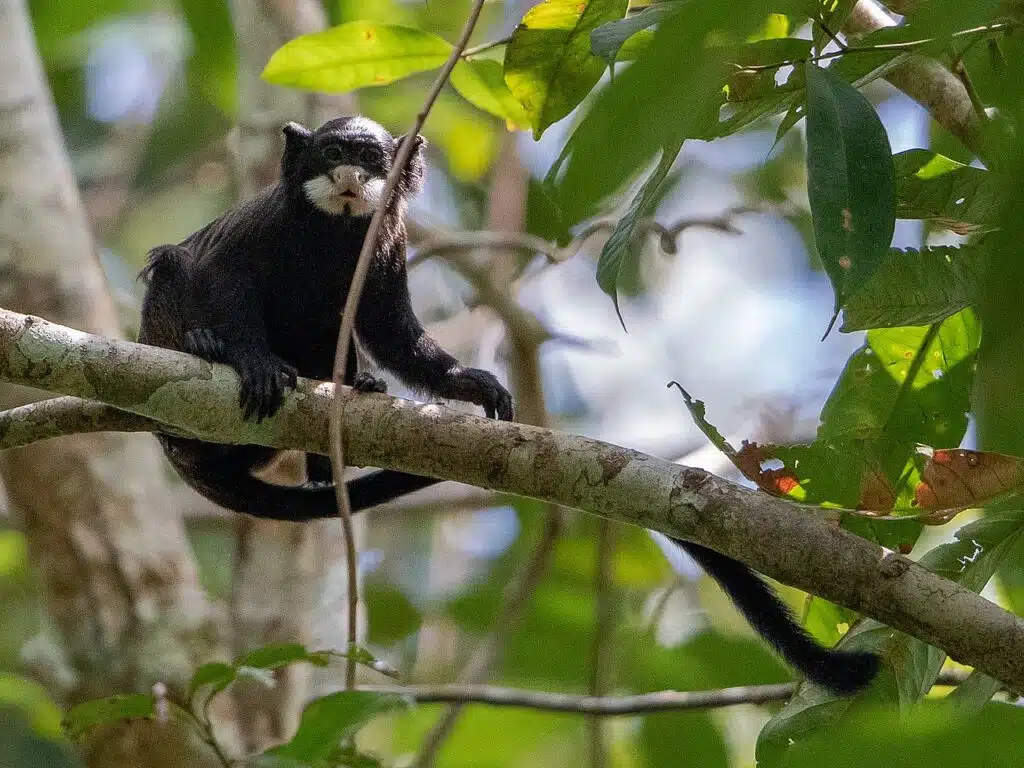
A species of the upper arid Amazon rainforest, Moustached Tamarins (Saguinus mystax) have a distinct appearance.
This is a black species that shows long white hairs that curl up looking similar to a human moustache.
Small and black, these monkeys spread their habitat through Brazil, Peru, and Bolivia.
Some of their populations are even found in wetter lowlands, but this is considered rare.
One of the triggers that make them change their rainforest region is the capacity to mix in with other tamarin species, also common in the Amazon Rainforest.
25. Monk Saki
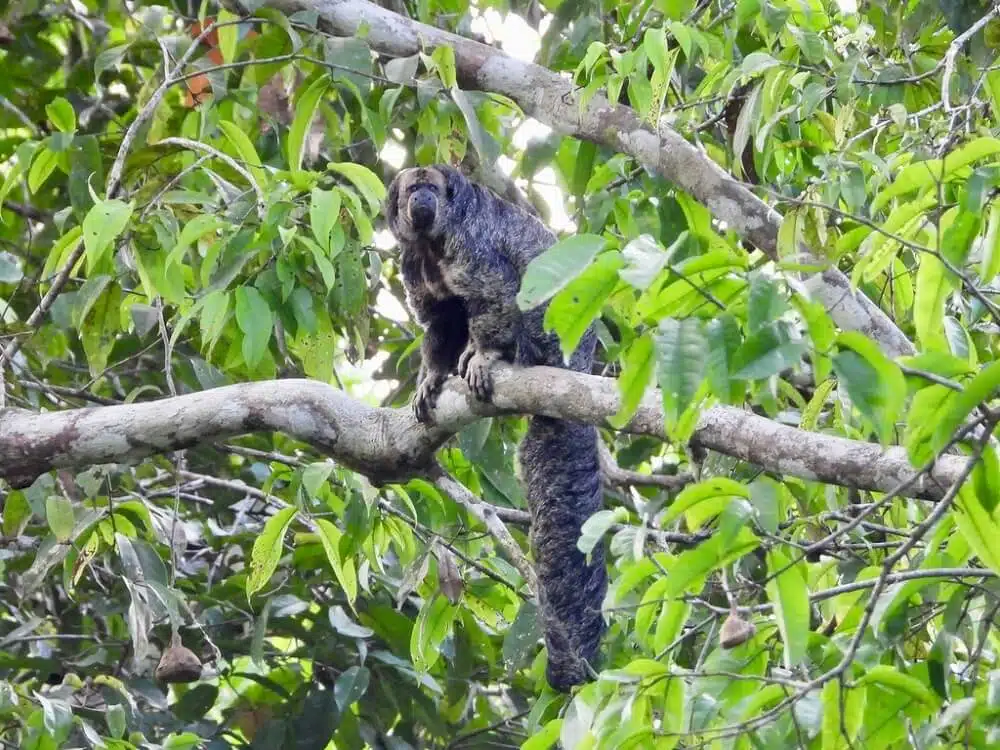
A species of Brazil and Peru rainforest, Monk Saki (Pithecia monachus) are among the monkeys that may never come down from trees.
Highly arboreal, this is a species that even prefers to live and breed higher up on trees.
It feeds on fruits, seeds, vertebrates, and invertebrates as well as on leaves, to a lesser extent.
This is a species marked by a dark appearance with black hairs dominating their bodies and golden-yellow sections contrasting their black hairs on the top of the head.
The monkeys themselves can be as small as 12 inches but can also grow to a more common size of 18-20 inches.
26. Black Titi
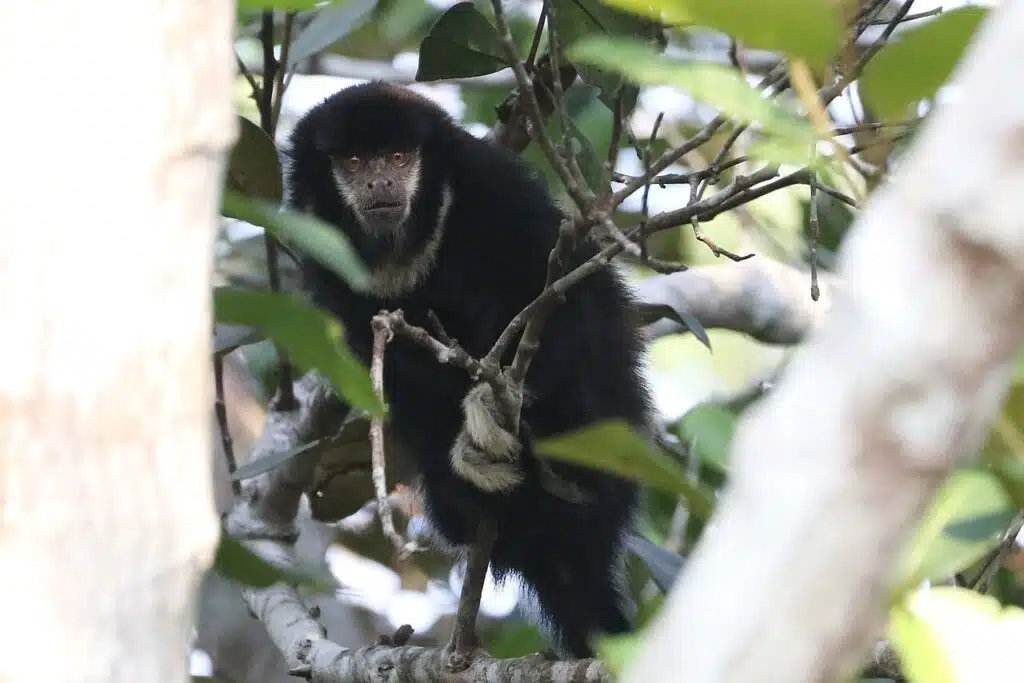
Black Titi monkeys (Cheracebus lugens) are native to the South American rainforest and they mostly live along rivers such as The Guayabero River.
This is a species of small dark monkey with a diverse diet that includes spiders, bugs, and fruit.
Black Titi monkeys breed in pairs and form long-lasting relationships, sometimes only breeding together for life.
This is one of the species with the most complex vocalizations in the rainforest. Loud vocalizations for different events are specific to these monkeys.
Male-female pairs often vocalize together for a long time in the morning.
27. Proboscis Monkey
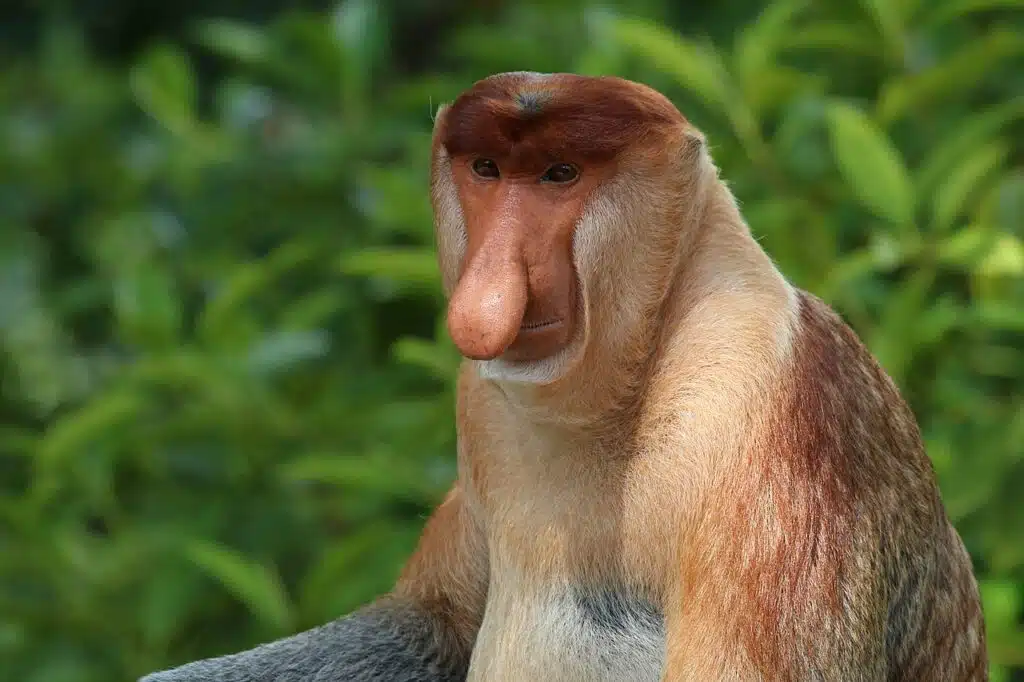
Mangrove forests of Southeast Asia are home to The Proboscis Monkey (Nasalis larvatus), a species identified by its long nose.
The nose is mostly long in males while females have shorter noses and offspring upturned noses.
According to some evidence, the length of the nose of male monkeys helps them vocalize louder and enjoy better breeding success.
Some of the longest noses of these forest-specific monkeys can even measure up to 4 inches.
28. Dusky Leaf Monkey
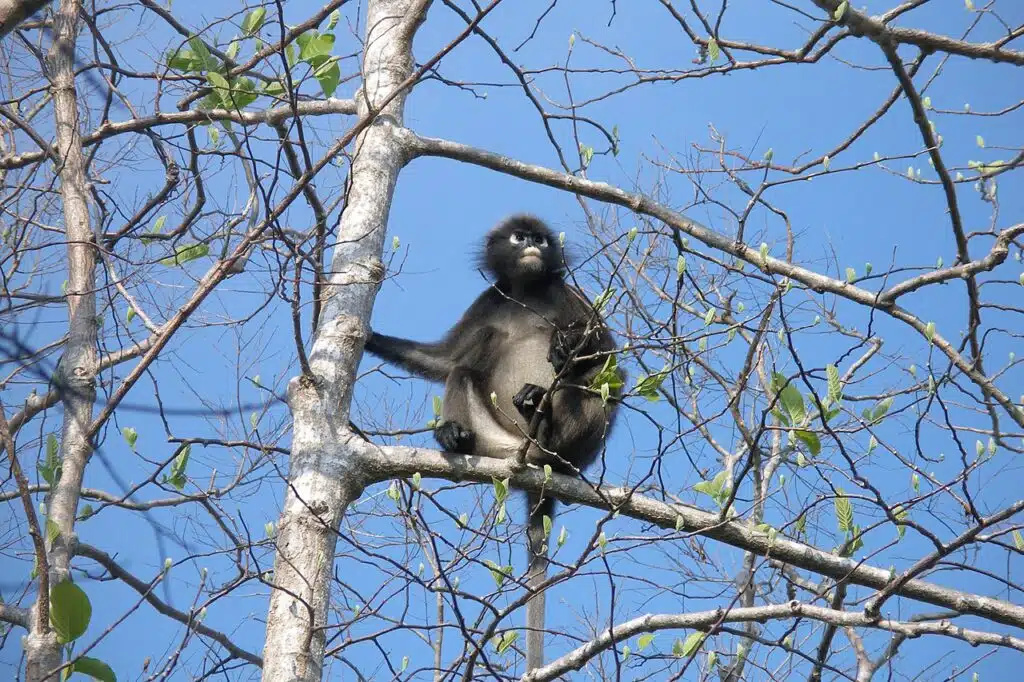
These types of monkeys (Trachypithecus obscurus) are native to Southeast Asia and are prevalent in Malaysia.
Initially orange, they darken to at least gray hairs or not black hairs once they become adults. A hairless black face is also specific to the adult Dusky Leaf Monkey.
Found across Thailand, this is also one of the monkeys with good swimming skills.
A migratory species, Dusky Leaf Monkeys are believed to have swam as far as Singapore, one of the new areas where they have been confirmed.
29. White-thighed Surili
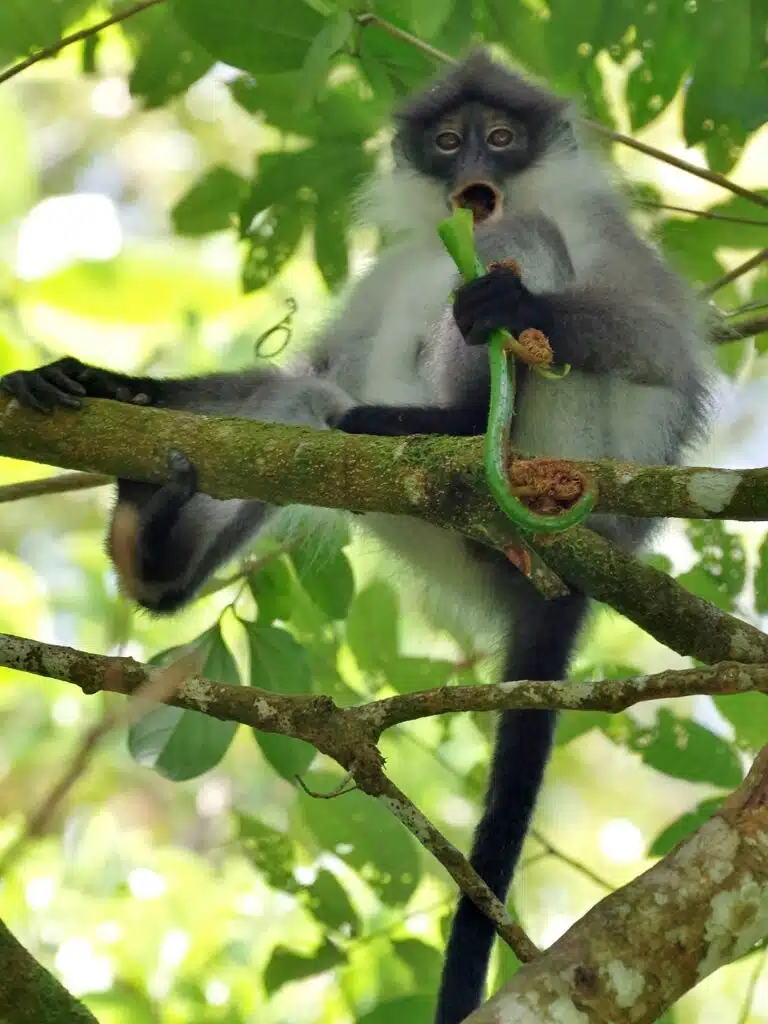
A bright and almost completely white type of monkey, The White-thighed Surili (Presbytis siamensis) is a species of The Malay Peninsula and nearby areas.
It lives in tropical and subtropical forests and also in swamps and it likes an area of high moisture for food abundance.
Spending most of its life up on trees, this is a species that lives in small groups formed from females and a single male that breeds with all females.
30. Southern Pig-tailed Macaque
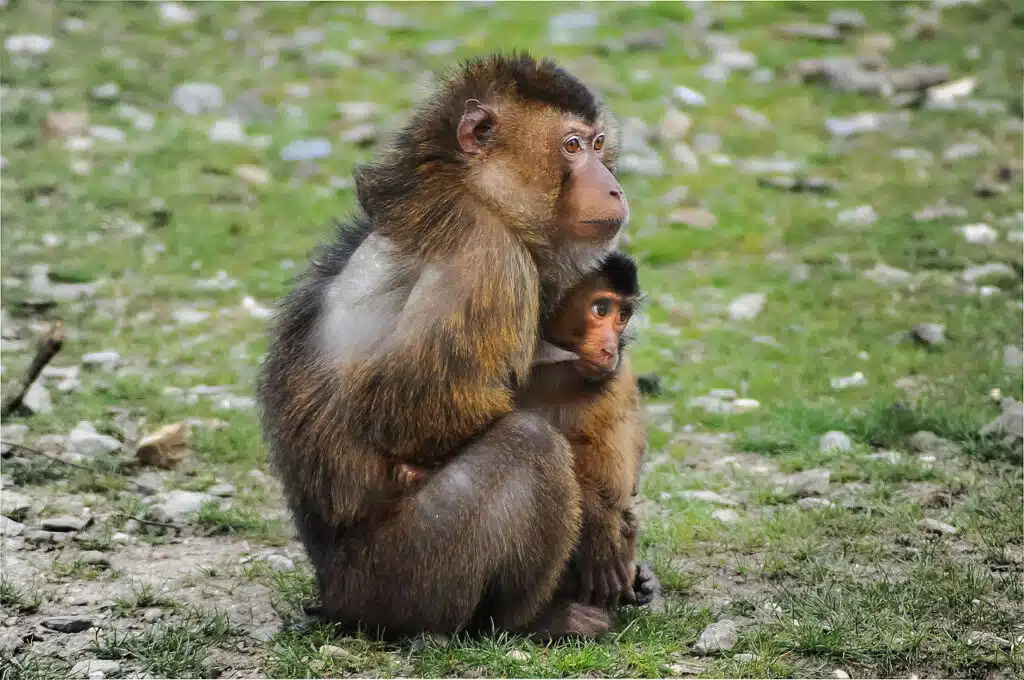
This atypical-looking macaque (Macaca nemestrina) has a short upturned tail which resembles the tails of pigs.
A species of Southeast Asia forests, this multi-state species shows buff-brown coloring and high intelligence.
They live in groups dominated by a female that breeds and a single male without a leadership role.
The role of the female leader is then passed down to the offspring.
Growing up to 19 inches, these monkeys feed on seeds, fruit, and mushrooms and help spread seeds of local palms.